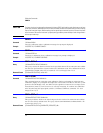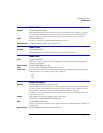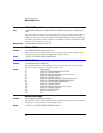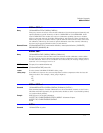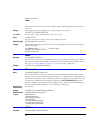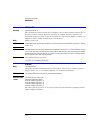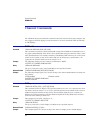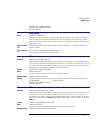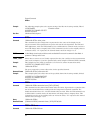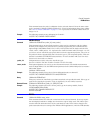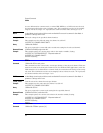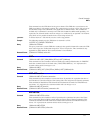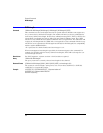
8-2
Channel Commands
BANDwidth
Channel Commands
The CHANnel subsystem commands control all vertical (Y axis) functions of the analyzer. You
may toggle the channel displays on and off with the root level commands VIEW and BLANk,
or with DISPlay.
BANDwidth
Command :CHANnel<N>:BANDwidth {HIGH | MID | LOW}
This command controls the channel bandwidth setting. When HIGH, the bandwidth is set to
the upper bandwidth limit. When LOW, a lower bandwidth setting is selected in order to min-
imize broadband noise. For modules with three bandwidths, MID will select the center band-
width. See the module section of the online Help for cutoff frequency specifications. <N>
represents the channel number and is an integer 1 to 4.
Example The following example sets the channel 1 bandwidth to “HIGH”.
10 OUTPUT 707;":CHANNEL1:BANDwidth HIGH"
Query :CHANnel<N>:BANDwidth?
The query returns the state of the bandwidth for the specified channel.
Returned Format [:CHANnel<N>:BANDwidth] {HIGH | MID | LOW}<NL>
Example The following example places the current setting of the channel bandwidth in the string vari-
able, Band$.
10 DIM Limit$[50] !Dimension variable
20 OUTPUT 707;":CHANNEL1:BANDwidth?"
30 ENTER 707;Band$
DISPlay
Command :CHANnel<N>:DISPlay {{ON | 1} | {OFF | 0}}[,APPend]
This command turns the display of the specified channel on or off. <N> represents the chan-
nel number and is an integer 1 to 4. Use the APPend argument in Eye/Mask mode to turn on
additional channels without turning off any other database signals that are currently on.
Without the APPend parameter, all other database signals in the Eye/Mask mode would be
turned off when turning a channel on.
Example This example sets channel 1 display to on.
10 OUTPUT 707;"CHANNEL1:DISPLAY ON"
Query :CHANnel<N>:DISPlay?
The query returns the current display condition for the specified channel.
Returned Format [:CHANnel<N>:DISPlay] {1 | 0}<NL>
Example This example places the current setting of the channel 1 display in the variable Display.



